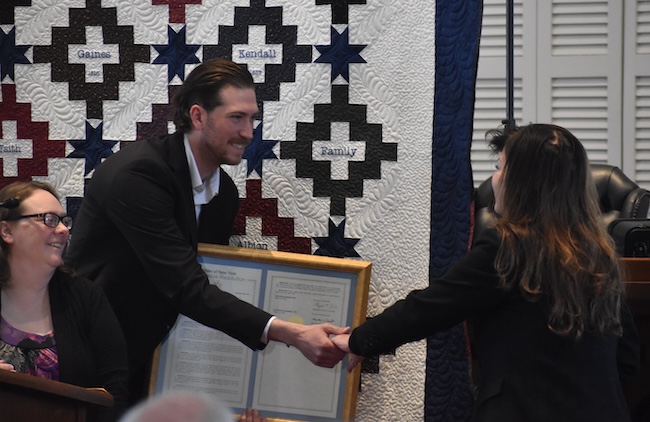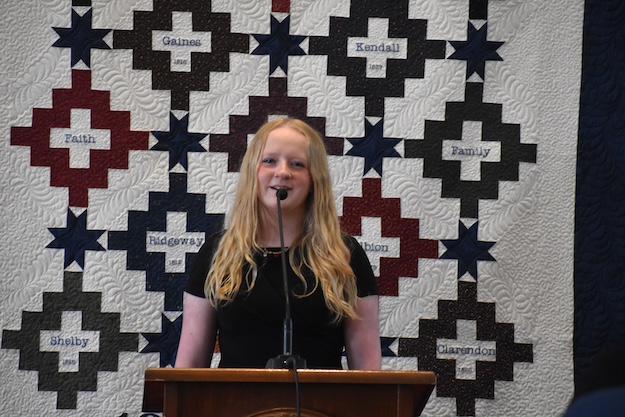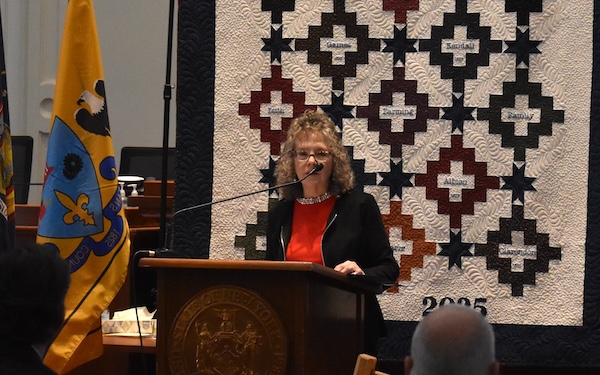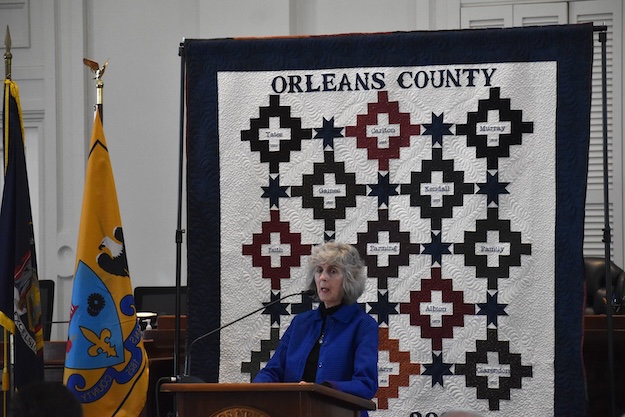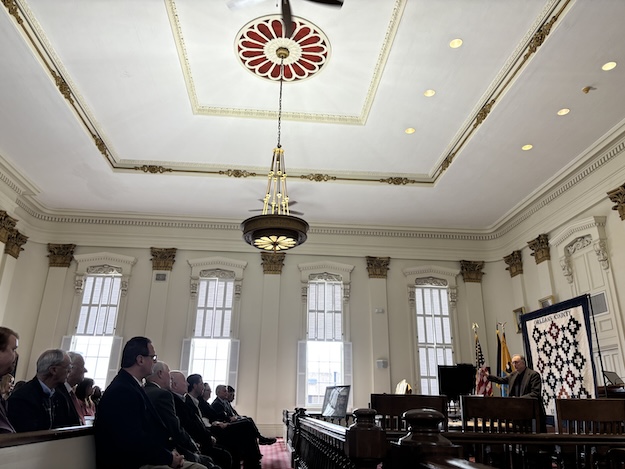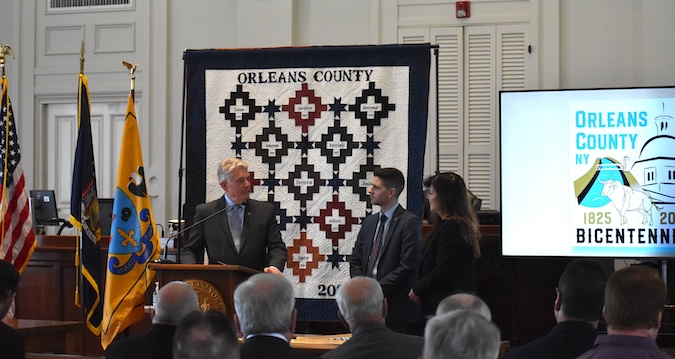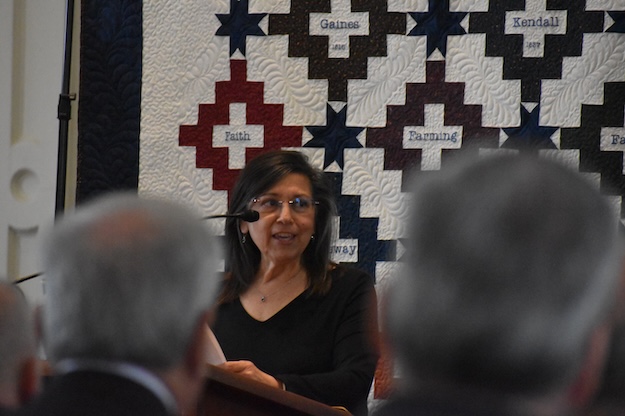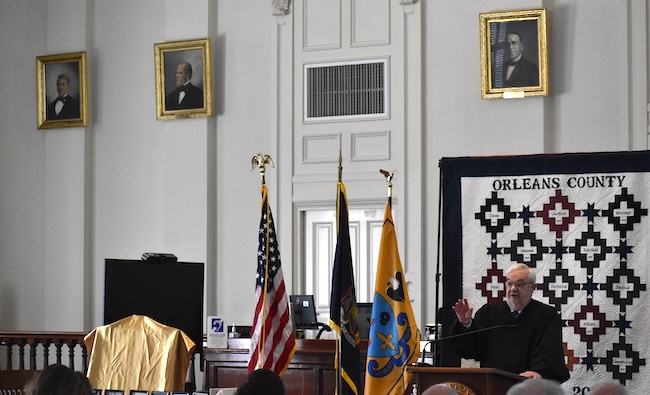Orleans County celebrates 200 years with ceremony at courthouse
Photos by Tom Rivers
ALBION – Orleans County Legislature Chairman Lynne Johnson welcomes a crowd of about 125 people to today’s bicentennial celebration for Orleans County.
The county for its first 165 years was run by a Board of Supervisors with the town supervisors from the towns also overseeing the county.
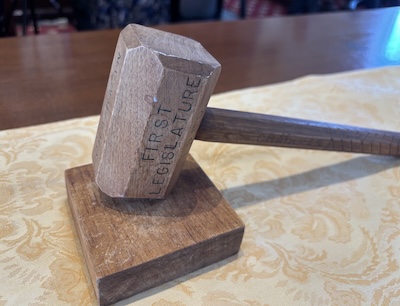
This gavel was carved from a walnut tree planted in 1856.
The government structure changed to a seven-member County Legislature in 1980. The Legislature’s seats have always been arranged in a semi-circular pattern, Johnson said. She quoted Stan Dudek, who was chairman of the new Legislature in 1980 and the first chief administrative officer beginning in 1982.
“That we all share equally in the rights, responsibilities and power vested in us as legislators; the side-by-side arrangement symbolic of our duty and desire to work together, with one common purpose, not to run, but to serve the County of Orleans; and facing the public, indicating our desire for clear and complete communication with the public we represent.”
Johnson also noted a gavel made from a walnut tree planted in 1856. Cary W. lattin, father of retired County Historian Bill Lattin, carved the gavel and presented it to Dudek at the first meeting of the Legislature in 1980.
“That means the wood from this gavel is almost as old as Orleans County itself,” Johnson said. “And just like this gavel, our county is as strong as ever.”
Orly the Ox enters the main courtroom in the Orleans County Courthouse during today’s bicentennial celebration for the county. About 125 people attended the ceremony.
The county has embraced the ox as a mascot for the bicentennial. Oxen were critical for the pioneers to travel on rough paths and settle the untamed land 200 years ago. The oxen were also needed to clear land and plow fields.
Orly (Isabella Zasa in costume) is lifting weights in his entrance to show the oxen’s brawn in helping the pioneer settlers.
The ceremony began with the ringing of the bell in the courthouse dome and the bells at the churches around the county, including the Courthouse Square.
Orleans County Legislature Chairman Lynne Johnson, right, accepts proclamations for Orleans County’s 200thanniversary today from Andrew Dugan, district director for State Senate Minority Leader Rob Ortt, and Jayleen Carney, executive assistant for Assemblyman Steve Hawley. The two state legislators were in Albany for budget negotiations but secured a state legislative proclamation for the county’s bicentennial.
Ortt and Hawley’s proclamation noted Orleans County was officially established as a separate entity from Genesee County on Nov. 12, 1824 and commenced its operations on April 15, 1825. The county’s name may honor either Andrew Jackson’s victory in the Battle of New Orleans or the French Duc d’Orleans. It symbolizes a compromise among the county’s early leaders, the proclamation states.
The completion of the Erie Canal in 1825 played a “transformative role in the county’s development,” Ortt and Hawley stated. The inexpensive transportation fueled the local economy and supported Orleans County’s early agricultural success, he stated.
Orleans County today prides itself on in diverse farms that cultivate vineyards and orchards, grow vegetables, raise livestock and produce milk.
“The county is also known for its competitive sports fishing and diligent workforce for manufacturing agriculture and commerce,” the proclamation states.
Johnson also accepted proclamations from U.S. Rep. Claudia Tenney’s Office, the Office of the Governor Kathy Hochul (presented by State Canal Commissioner Brian Stratton) and the County Legislature.
Mackenzie Poynter, a Medina High School student, sang the national anthem, “The Star-Spangled Banner.”
Tara Thom, owner of the Town and Country Quilt Shop, spearheaded the creation of the bicentennial quilt. She speaks at the podium. She is joined by quilters Carrie Standish, Catherine Hooker and Brenda Radzinski.
Others who helped make the quilt include Kathryn DeMarco, Gayle Ashbery, Irene Henion and Susan Landis.
The quilt includes the 10 towns and when they were established and three foundational blocks of Farming, Faith and Family.
Carol Culhane also presented a painting for the bicentennial that she says honors the pioneers who tamed the land and lived modestly in log cabins. In her painting, she shows Main Street in Albion in the 1800s, and has images of a log cabin with livestock, and paintings of the County Courthouse and the Clerks’ Building.
Decades before the courthouse (built in 1858) and Clerks’ Building (constructed in 1888) were erected on the Courthouse Square, there was a log cabin there. A historical marker at the courthouse lawn notes the first settlers in Albion in 1811 built a log cabin where the Clerks’ Building stands. The late Al Capurso had that marker installed in 2013 to honor those pioneers – William McAllister and his wife.
A cake made by Peggy Bropst included a map of the county with the 10 towns: Albion, Barre, Carlton, Clarendon, Gaines, Kendall, Murray, Ridgeway, Shelby and Yates.
Holley Mayor Mark Bower served as master of ceremonies and gave a welcome address and the closing remarks.
“Like many other places in our country, we have seen many challenges and successes, overcome adversity, and marched on due to the founders of our county and those who have followed since,” Bower said.
Four county legislators stand and present a proclamation from the County Legislature. From left include Ed Morgan, John Fitzak, Fred Miller and Lynne Johnson.
The proclamation notes the 10 towns in the county and four villages of Albion, Holley, Lyndonville and Medina.
The county is “richly endowed with natural resources from shores of Lake Ontario to the Iroquois National Wildlife Refuge.”
The county has benefited from the Erie Canal, which opened in 1825, and continues to be a vibrant agricultural producer.
“Immigrants from many countries have found opportunity in Orleans County and made their homes here,” the proclamation states.
Many of those immigrants first cleared the land, dug the canal, quarried Medina sandstone, and labored in fields and factories.
Catherine Cooper, the current county historian, shared her admiration for the courage and heartiness of the pioneers who often suffered great hardship, losing young children to illness and enduring extreme financial stress.
“One wonders how they survived those early years,” said Cooper, who also heads the county’s bicentennial committee.
This display of portraits honors people who have served as Orleans County historian. County historians from left include Katherine Rowley, 1934-1938; Theta Hakes Brown, 1938-1944; Joseph Achilles, 1944-1957; Cary Lattin, 1958-1975; Arden McAllister, 1975-1978; C.W. “Bill” Lattin, 1979-2014; and Matt Ballard, 2015-2020.
Bill Lattin, retired Orleans County historian, shares how the County Courthouse was built in 1858 with the county committing to spend $20,000 on the building. It came in $153 under budget.
The ornate Greek Revival building was modelled after one in Wayne County. The Orleans County Courthouse remains in use as a courthouse.
Canal Commissioner Brian Stratton, left, is joined by JW Cook, Gov. Hochul’s Finger Lakes regional representative, in presenting a proclamation to Lynne Johnson.
Stratton said the Erie Canal, also celebrating its bicentennial this year, will continue to be an important resource for Orleans County for many years to come.
Sue Starkweather Miller, the Village of Albion historian and bicentennial committee member, said the community is fortunate to have so many first-hand accounts from the pioneers.
The Orleans County Pioneer Association formed in 1859 and a book of their experiences settling in Orleans County was published by Arad Thomas in 1871.
The county historians also have written many columns on local history, and the community has a deep database of older newspapers with local history.
Starkweather noted the Pioneer Association met in the same courthouse building in 1859.
Orleans County Court Judge Sanford A. Church speaks at the celebration today. Church comes from a lineage of lawyers and judges, including the portrait of the second man from left.
Church can trace his family ties to Orleans County back to 1835, when Sanford E. Church moved to Albion. Sanford E. later became county district attorney, assemblyman, state comptroller and lieutenant governor. His career culminated in service as chief judge of the Court of Appeals, New York’s highest court.




























